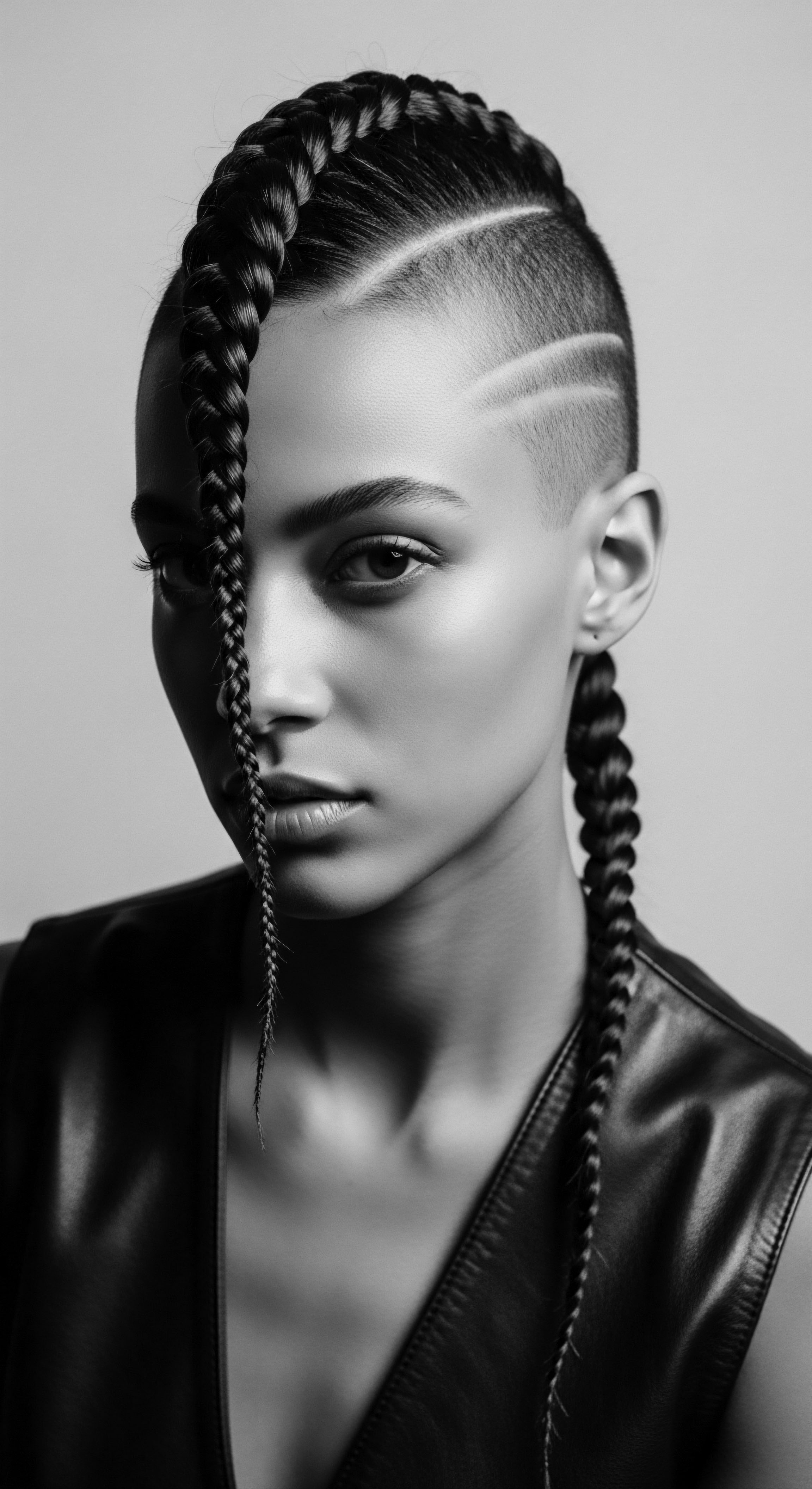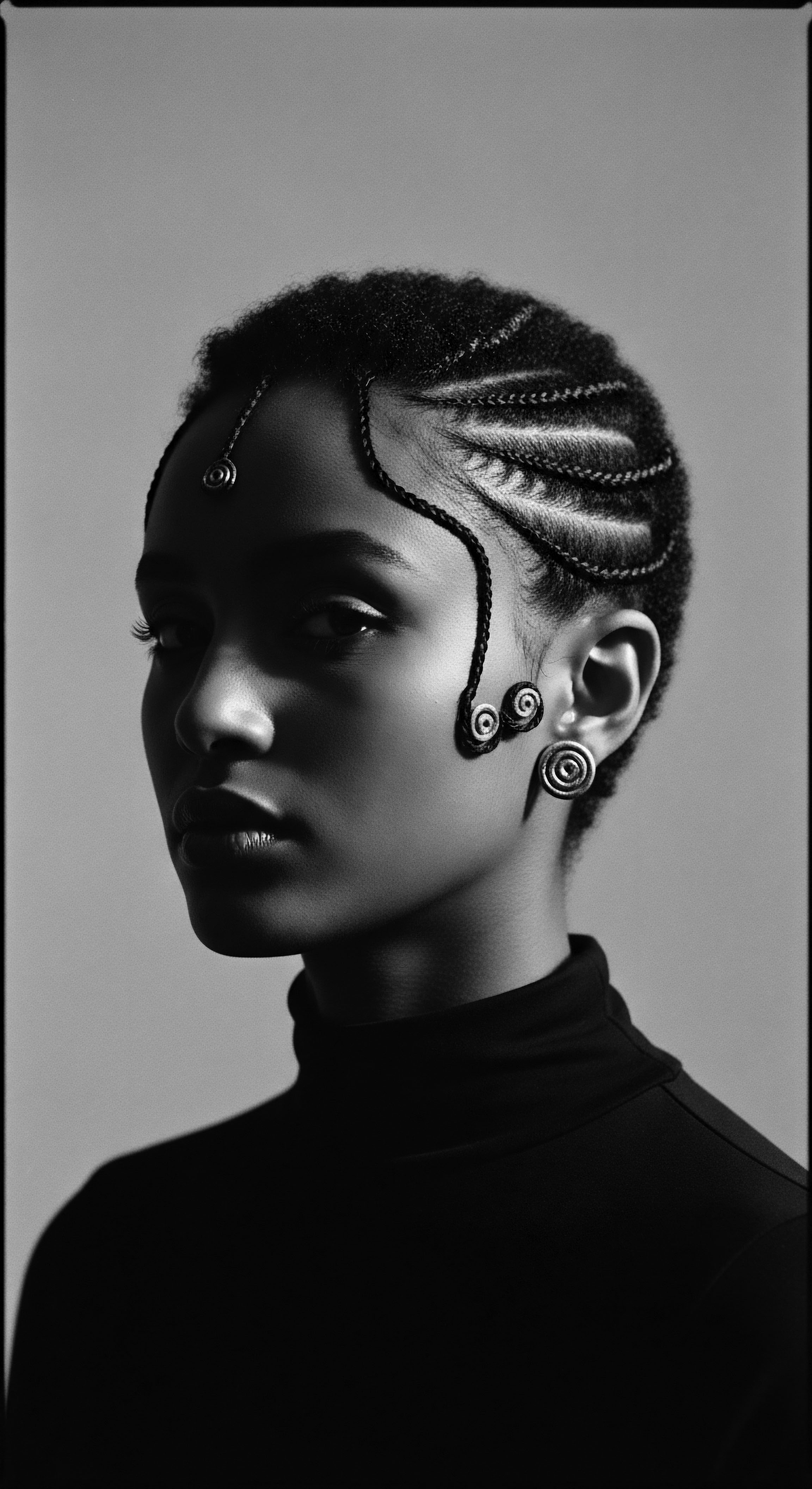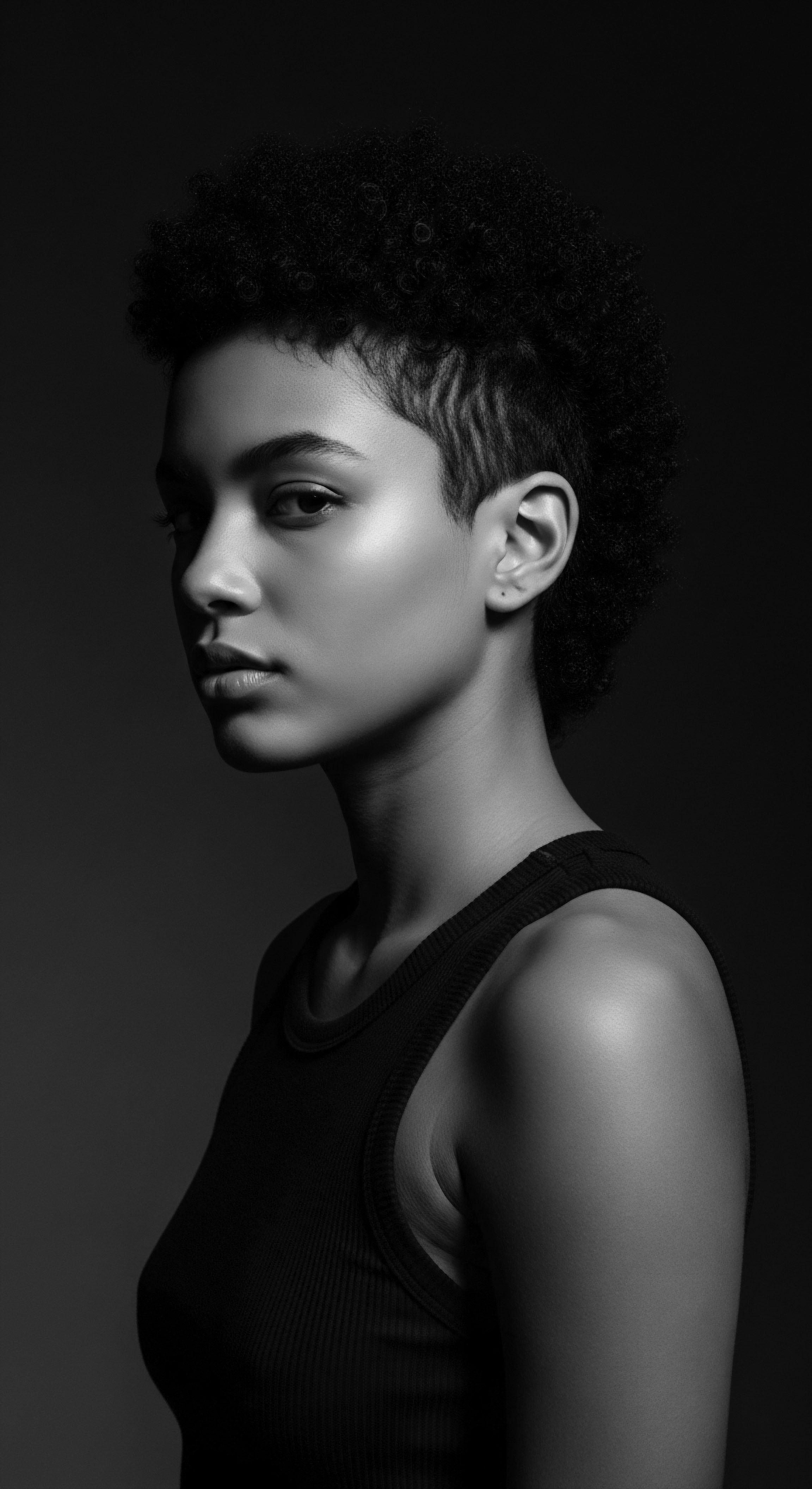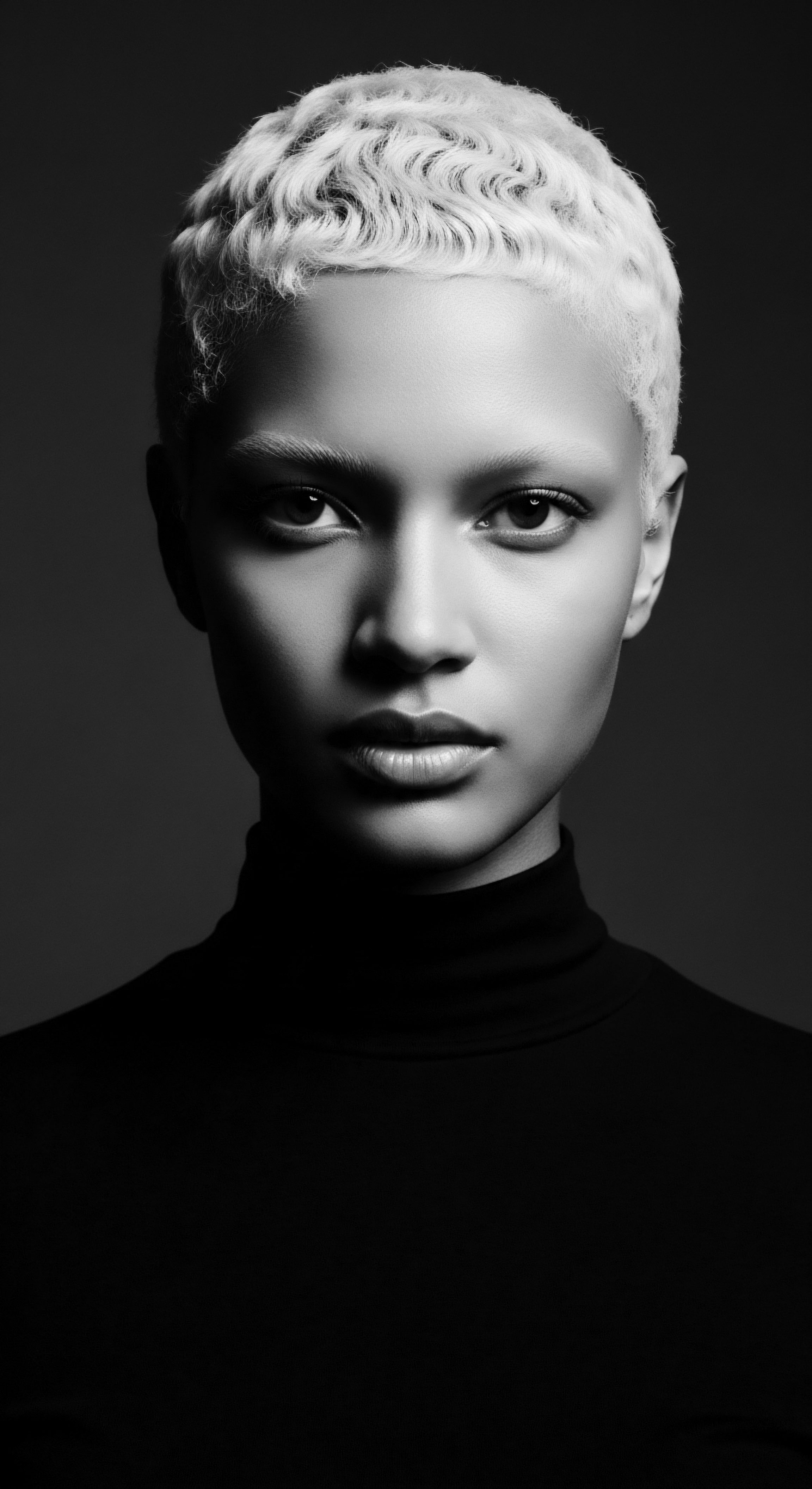
Roots
To journey into the ancestral uses of shea butter for textured hair is to trace a lineage, to honor a wisdom carried on the winds of time, echoing from the sun-drenched savannas of West Africa. For those of us with hair that speaks in coils, kinks, and waves, this golden butter is more than a botanical ingredient. It is a touchstone to the past, a whispered secret passed from elder to child, a symbol of resilience and profound connection to the earth itself.
What deep practices shaped the way our ancestors tended to their crowns, drawing on the bounty of the shea tree? To understand this, we must reach back, beyond the modern aisle of products, into the very anatomy of textured hair, as it was understood and nurtured in its most elemental forms.
The Vitellaria Paradoxa, often referred to as the ‘karite tree’ or ‘tree of life,’ grows abundantly across the Sahel belt, a vast region spanning from Senegal to Uganda. This tree has for millennia offered its nourishing fruit, the shea nut, a core component in the wellness and beauty rituals of countless African communities. The process of extracting shea butter, a labor of generations, remains largely an artisanal endeavor, predominantly carried out by women.
They hand-harvest the nuts, sun-dry them, and then grind them to release the butter. This meticulous practice ensures the purity of the product while sustaining economic opportunities for thousands of women.
Ancestral shea butter use for textured hair care reflects a deep, sustained relationship with the land and its botanical gifts.

Hair Anatomy and Traditional Knowledge
Textured hair, with its unique helical structure, presents particular needs for moisture retention and protection. Ancient African communities, without the benefit of microscopes or advanced chemical analysis, developed an intuitive yet remarkably precise understanding of these needs. They observed how shea butter, rich in Fatty Acids, Vitamins A and E, offered an unparalleled ability to seal in moisture, mitigate environmental damage, and promote scalp health. This knowledge wasn’t codified in scientific journals but lived in the very hands that kneaded the butter, in the communal grooming sessions, and in the tangible results of strong, lustrous hair.
Consider the hair strand itself. Its outer layer, the cuticle, is a protective sheath of overlapping scales. In textured hair, these scales may be more lifted or unevenly aligned, allowing moisture to escape more readily. Ancestral practices with shea butter addressed this intrinsic characteristic.
By applying the butter, particularly to damp hair, they created a protective barrier that smoothed the cuticle, reducing moisture loss and contributing to softness. This function, now understood through the lens of modern science as acting as a sealant, was a daily reality for those who relied on the karite tree.

How Did Ancestral Practices Address Hair Porosity?
The concept of hair porosity, though a modern term, finds its echoes in ancestral practices. Communities observed how certain hair types absorbed and retained moisture differently. For hair that seemed to lose moisture quickly (what we now term high porosity), shea butter, with its heavier consistency and sealing properties, would have been particularly beneficial. It offered a substantial coating, providing sustained hydration against the elements.
For hair that tended to repel water (low porosity), perhaps lighter applications or warmer, more pliable forms of the butter were employed to encourage absorption. These subtle adjustments speak volumes about generations of keen observation.
The tradition of working shea butter into hair often involved warming it, a simple act that enhances its spreadability and absorption. This was not a random choice. The subtle shift in temperature allows the butter’s natural fatty acids, such as oleic and stearic acids, to become more pliable, better able to coat and penetrate the hair shaft. This process reduces frizz and allows for greater shine, as the smooth cuticle reflects light more evenly.

Essential Lexicon and Cultural Classifications
The language surrounding textured hair in ancient African societies reflected its deep cultural value. Terms were not merely descriptive of texture, but often tied to social status, spirituality, and communal identity. While specific words varied across the vast continent, the underlying reverence for hair was consistent. Hair was considered a conduit to the spiritual realm, a symbol of wisdom and strength, and a living chronicle of personal and communal narratives.
Instead of formal classification systems, communities developed nuanced understandings based on observable traits and practical care needs. The practices around shea butter were integrated into this understanding. For example, hair meant for intricate braiding might be prepared with shea butter to provide slip and strength, while hair for ceremonial adornment might receive a more generous application to impart a lustrous sheen.
- Karite ❉ The name for the shea tree in the Dioula language, meaning ‘tree of life,’ reflecting its central importance.
- Women’s Gold ❉ A common appellation for shea butter, acknowledging the economic empowerment and livelihood it provides for women in shea-producing regions.
- Ose Dudu ❉ A Yoruba term for African black soap, often made with shea butter, used for cleansing hair and skin.
The traditional knowledge encompassed an understanding of hair’s seasonal needs, environmental protection, and even its spiritual alignment. Shea butter, therefore, was not simply a cosmetic; it was a sacred balm, a protector, and a tool for communal bonding. This holistic perspective laid the foundation for textured hair care, demonstrating a profound ancestral relationship with the natural world and the body.

Ritual
The ancestral journey with shea butter moves beyond foundational understanding into the sphere of deliberate action ❉ the rich tapestry of ritual. Here, the use of this golden butter transformed into a living art form, a symphony of touch, intention, and communal practice that shaped textured hair into expressions of identity, status, and protection. These rituals, passed through generations, were sophisticated practices that anticipated the very challenges textured hair faces today, offering solutions centuries before modern science articulated them.
In West Africa, the rhythmic pounding of shea nuts, the boiling of the oil, and the hand-kneading of the butter were themselves rituals, imbued with purpose and shared effort. The resulting butter, with its distinct scent and texture, was then applied in various forms to hair, laying the groundwork for styling, adornment, and health. These applications were far from haphazard; they were precise, serving specific functions within the diverse hair traditions of the continent.

Protective Styling and Ancient Applications
Protective styles—braids, twists, cornrows, and various forms of locs—have roots deeply embedded in African history and heritage. These styles offered practical benefits such as reducing hair manipulation, protecting strands from environmental stressors, and retaining length. Shea butter played a central role in their creation and maintenance. Its emollient properties provided slip, easing the braiding and twisting process, minimizing breakage, and ensuring the finished style remained supple and hydrated.
An intriguing historical example of shea butter’s protective use comes from the Chadian Basara Arab women, known for their elaborate hair rituals involving Chébé powder. While Chébé itself does not stimulate hair growth, it was traditionally mixed with moisturizing substances, including shea butter. This blend was applied to hydrated hair, which was then meticulously braided to seal in moisture and offer protection. This practice, passed down through generations, highlights shea butter’s historical role in length retention and safeguarding strands from the harsh desert climate.
Hair care rituals with shea butter in ancestral communities were often communal activities, reinforcing social bonds.

How Was Shea Butter Incorporated into Braiding Traditions?
The act of braiding was, and continues to be, a deeply communal activity in many African cultures. Mothers, daughters, and friends would gather, sharing stories and wisdom while meticulously styling hair. During these sessions, shea butter would be warmed and worked through sections of hair. The butter acted as a conditioning agent, preparing the strands for manipulation.
It reduced friction during braiding, allowing for tighter, neater patterns that could last longer. The fatty acids in the butter also coated the hair shaft, providing a protective layer against external elements. This careful application contributed to the longevity and health of these intricate styles.
Beyond braids, shea butter was vital for maintaining other protective styles and for general daily care. For example, it could be used as a pre-shampoo treatment, applied generously to hair and scalp before cleansing to guard against the stripping effects of traditional cleansers. It also served as a leave-in conditioner, particularly for dry areas and ends, to maintain hydration throughout the day. These usages reflect a sophisticated understanding of how to mitigate dryness and fragility inherent to textured hair.

Tools and Transformations with Shea Butter
The tools used in conjunction with shea butter were often simple yet effective. Hand-carved combs and picks, sometimes crafted from wood or bone, would be used to section and detangle hair, with shea butter providing the necessary lubrication. The warmth of human hands massaging the butter into the scalp and strands was a tool in itself, enhancing absorption and promoting circulation.
The application of shea butter was a transformative process, turning dry, brittle hair into soft, pliable crowns. This transformation was not merely aesthetic; it held deeper cultural meaning. Well-cared-for hair often signified health, status, and connection to one’s lineage. The use of shea butter contributed directly to these outcomes, making it a powerful agent of personal and communal expression.
| Tool Hand-Carved Combs |
| Ancestral Use with Shea Butter Used for detangling hair softened with shea butter, minimizing breakage. |
| Tool Fingers and Palms |
| Ancestral Use with Shea Butter The primary tools for warming and massaging shea butter into hair and scalp, ensuring deep penetration and even distribution. |
| Tool Ceremonial Wraps |
| Ancestral Use with Shea Butter After shea butter application, hair was often wrapped to protect styles and allow the butter to deeply nourish, sometimes with symbolic cloths. |
| Tool These tools, coupled with shea butter, facilitated centuries of effective and culturally significant hair care. |
The art of hairstyling, supported by shea butter, extended to complex patterns that could convey age, marital status, or tribal affiliation. The butter aided in defining these patterns, adding sheen and holding them in place. The versatility of textured hair, often seen as a divine gift, was fully realized through these traditional methods, with shea butter serving as a crucial element in achieving both beauty and cultural expression.

Relay
The story of shea butter in textured hair practices reaches across continents and generations, a profound relay of wisdom from ancestral lands to contemporary understanding. This journey highlights how ancient wellness philosophies, deeply informed by a symbiotic relationship with nature, continue to shape holistic care, problem-solving, and the very concept of hair health. The connection is not simply historical; it is a living continuum, constantly influencing and being influenced by Black and mixed-race experiences globally.
The original intent behind shea butter use was never limited to mere aesthetics. It was about holistic wellbeing, spiritual alignment, and protection from environmental rigors. The ancestral approach to hair care recognized the scalp as an extension of the body’s overall health, and shea butter, with its known anti-inflammatory and moisturizing attributes, was central to this perspective.

Building Personalized Regimens from Ancestral Wisdom
Ancestral communities didn’t follow rigid, universal regimens. Instead, they adapted their practices based on individual needs, climate, and available resources, a subtle customization that mirrors today’s call for personalized hair care. Shea butter, being a versatile ingredient, lent itself to this adaptable framework.
It was used differently for infants, for hair exposed to harsh sun, or for preparing hair for ceremonial styles. This inherent flexibility in application, rooted in observation and learned wisdom, is a powerful lesson for modern regimens.
A powerful case in point lies within the daily moisturizing routines practiced across many Ghanaian families. As recounted by geographer and researcher Teju Adisa-Farrar, moisturizing the entire body, including the hair and face, with substances such as Ghanaian shea butter, was considered a fundamental part of daily care. This was not a luxury; it was a necessary practice for protecting skin and hair in varying climates, particularly for young Black girls for whom mainstream products were not designed. This consistent, daily application of shea butter highlights a deeply ingrained ancestral understanding of continuous hydration and environmental protection as core elements of hair health.
Shea butter’s journey from ancestral remedy to global staple mirrors the diaspora’s resilience and reclamation of heritage.

What Can Modern Science Confirm about Shea Butter’s Ancestral Efficacy?
Modern scientific inquiry often validates the wisdom of ancestral practices. Shea butter, derived from the Vitellaria paradoxa tree, possesses a rich profile of beneficial compounds. It contains triterpenes, which are recognized for their anti-inflammatory properties, offering scientific support for its traditional use in soothing scalp irritation.
The presence of fatty acids, such as oleic and stearic acids, allows shea butter to penetrate the hair cuticle, providing deep moisture and contributing to its sealing capabilities. This scientific understanding clarifies why our ancestors intuitively reached for shea butter to combat dryness and fortify hair strands.
The butter’s Vitamin A and Vitamin E content acts as antioxidants, providing a natural shield against environmental damage and promoting overall scalp health. This aligns with ancestral uses for hair protection and maintaining hair vitality in challenging climates. The scientific properties provide a concrete explanation for the efficacy observed through generations of consistent application.

The Nighttime Sanctuary and Holistic Influences
Nighttime rituals hold a special place in ancestral hair care, recognizing the importance of protection and deep conditioning during rest. While modern bonnets and silk scarves have their place, the underlying principle of protecting hair from friction and moisture loss during sleep is an ancient one. Shea butter would have been applied before wrapping hair, allowing its conditioning properties to work overnight, leaving hair soft and prepared for the day.
The holistic philosophy of ancestral wellness extends beyond topical application. Hair health was seen as intertwined with spiritual wellbeing, diet, and communal harmony. In many African traditions, hair was considered a sacred antenna connecting individuals to spiritual realms and ancestors.
The act of caring for hair, including the application of shea butter, became a sacred ritual, a form of energetic sovereignty and spiritual blessing. This deep reverence for hair imbued every act of care with profound meaning.
Shea butter’s role in spiritual cleansing and protection is also evident. In some communities, it was used as part of ritualistic applications to the body and hair, symbolizing purity and connection. This reinforces the idea that hair care was never isolated but integrated into the broader spectrum of daily life, belief systems, and cultural expression.
- Anointing Scalp ❉ Warming shea butter, sometimes infused with herbs, then massaging it into the scalp for nourishment and spiritual blessing.
- Protective Wrapping ❉ Applying shea butter before covering hair with natural materials to preserve moisture and shield from dust and elements.
- Communal Grooming ❉ Sharing shea butter during hair styling sessions, fostering connection and the passing of traditions.
The legacy of ancestral shea butter use in textured hair care is not a static historical record. It is a dynamic, living archive that continues to inform and inspire. It speaks to the power of natural ingredients, the wisdom of observation, and the enduring connection between physical care and spiritual wellbeing. As we look to the future of textured hair care, the echoes of these ancient practices, fortified by the golden balm of the shea tree, offer a guiding light.

Reflection
The journey through the ancestral uses of shea butter for textured hair culminates in a realization ❉ this golden balm is more than a product; it is a repository of heritage, a tangible link to the ingenuity and resilience of our forebears. It carries the wisdom of hands that knew the earth, the patience of generations dedicated to communal care, and the deep understanding of hair as a sacred crown. The very fibers of textured hair, with their unique inclinations and strength, have been shaped, protected, and celebrated through this enduring botanical gift.
Roothea’s ‘Soul of a Strand’ ethos finds its living breath in these narratives. Each application of shea butter, whether in a modern formulation or raw from the source, echoes centuries of women tending to their families, crafting beauty from nature’s abundance, and reinforcing identity through meticulous care. This is a story of continuity, of a legacy that refuses to be diminished, even as it adapts and evolves.
The ancestral knowledge woven into shea butter’s history reminds us that true wellness for textured hair is always holistic, embracing its biological needs alongside its profound cultural and spiritual significance. It is a call to recognize the deep currents of the past flowing through our present practices, honoring a heritage that remains vibrant and unbound.

References
- Abena, Boamah-Acheampong. The Shea Butter Handbook ❉ Traditional Uses, Modern Applications, and Sustainable Practices. Green Earth Publications, 2023.
- Johnson, Chelsea. “Kinky, Curly Hair ❉ A Tool of Resistance Across the African Diaspora.” USC Dornsife, 2016.
- Muturi, N. W. Traditional African Cosmetics ❉ A Cultural and Scientific Exploration. Ancestral Roots Press, 2022.
- Olabisi, Kemi. African Hair ❉ History, Traditions, and Cultural Significance. Heritage Books, 2019.
- Olufemi, A. Ethnobotany of African Oils and Butters in Traditional Medicine. Botanical Studies Press, 2021.
- Sall, Mariama. Women’s Gold ❉ The Economic and Cultural Impact of Shea Butter in West Africa. Sahel Publishing, 2020.
- Smith, J. A. The Science of Natural Hair ❉ Understanding Textured Strands. Hair Health Collective, 2023.
- Uchendu, Chinwe. Hair as Heritage ❉ Black Women’s Practices of Self-Care and Identity. Diasporic Press, 2024.
